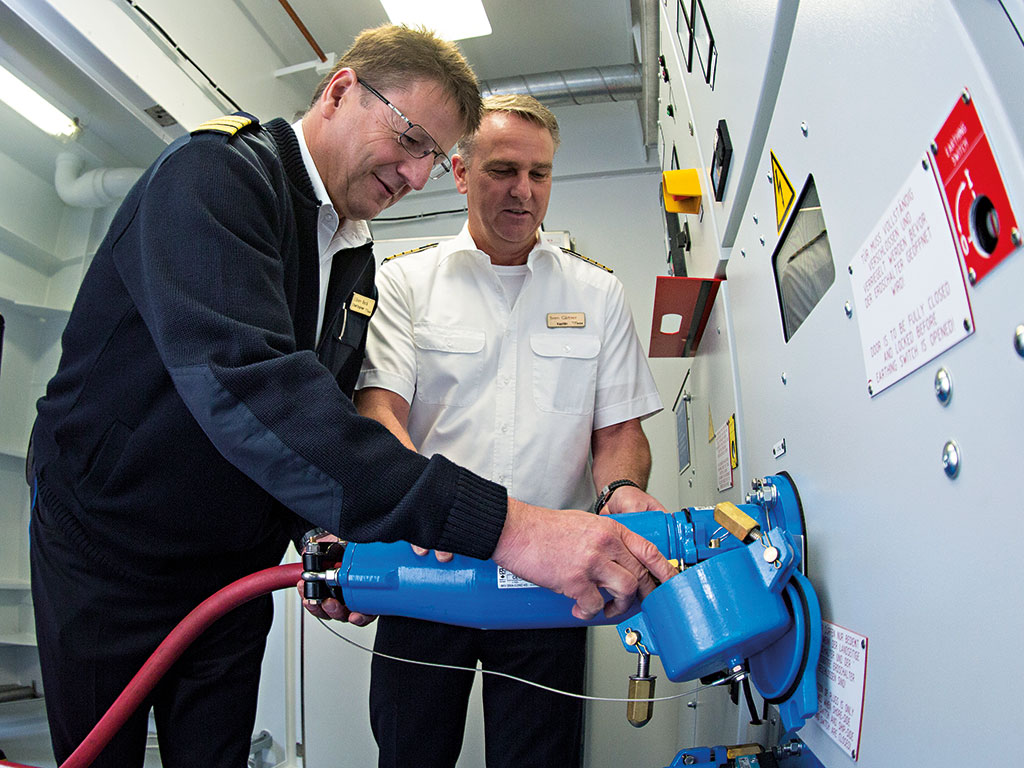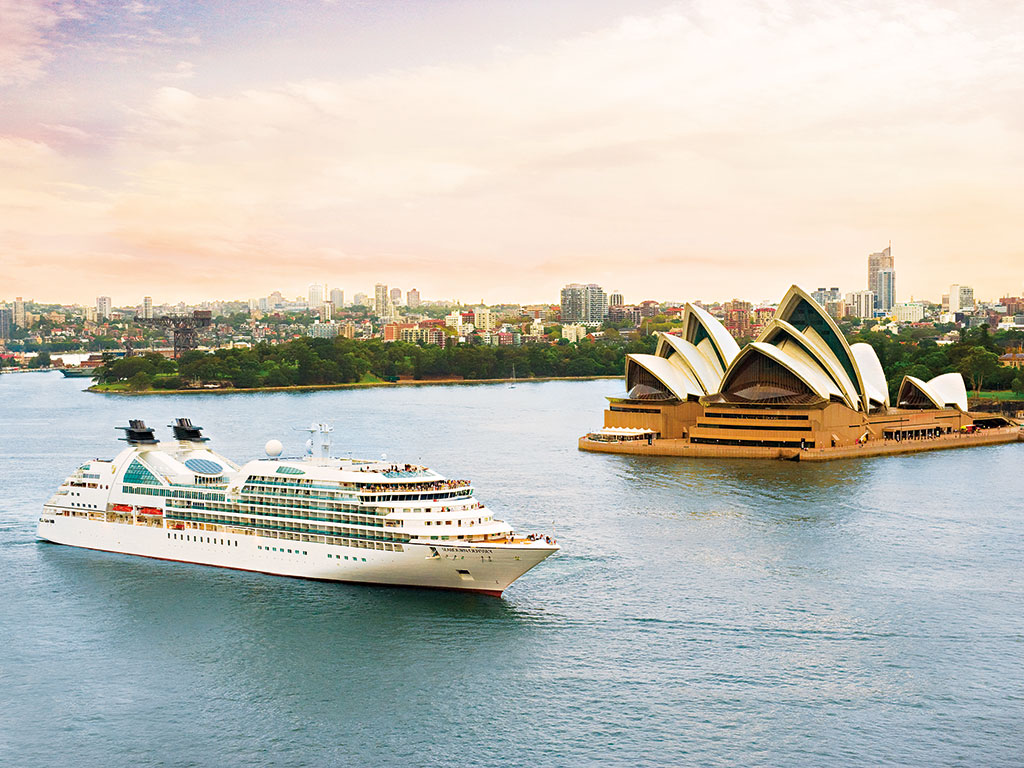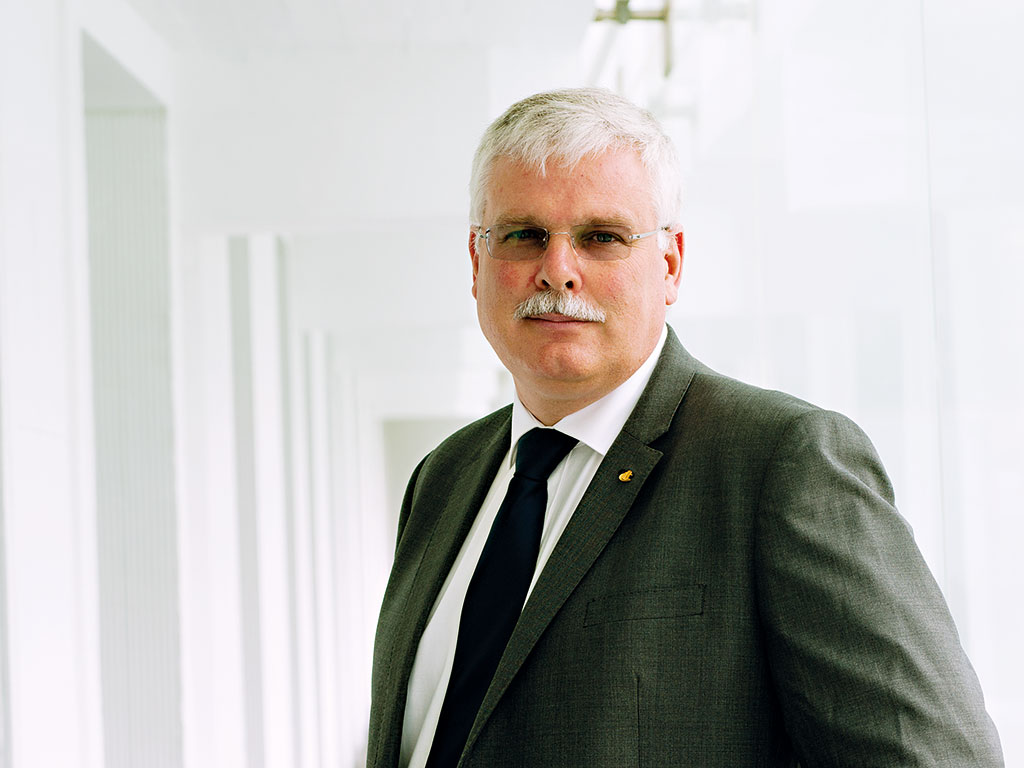Carnival Corporation banks on a sustainable future
As the first in the cruise industry to build LNG-powered ships, Carnival Corporation is banking on a more sustainable future and cleaner air, says Tom Strang, Senior Vice President of Maritime Affairs for the company

AIDA’s LNG Hybrid Barge is plugged in as another clean fuel. The barge generates power docked ships can draw on
There are nearly 50,000 global ocean-going maritime (or commercial) vessels, and the maritime industry is responsible for three to four percent of global CO2 emissions, with much of that attributable to the use of heavy fuel oil (HFO). However, for perspective, with roughly 300 cruise ships in the world, the cruise industry represents less than one percent (0.6 percent) of the nearly 50,000 maritime vessels.
Cruise ships are a small part of the overall maritime industry, but cruise companies such as Carnival Corporation have consistently demonstrated industry leadership for environmental and sustainability practices. The latest example is Carnival’s decision to launch four LNG-powered next-generation cruise ships for Costa Cruises and AIDA Cruises. This is a significant development, as the company will be the first to use LNG in ports and on the open sea. Once completed, the transition will lead to a considerable reduction in emissions and demonstrate to others, both in the cruise industry and overall maritime industry, that LNG is a viable alternative.
“Compared to HFO, LNG greatly reduces air emissions: nitrogen oxides by up to 80 percent and particulate matter by around 85 percent”, said Strang. “Because LNG doesn’t contain sulphur, these emissions are eliminated completely. Greenhouse gas emissions are reduced, too. With HFO or [machine gas oil (MGO)], you still have issues with particulate matter. With HFO, you would still have to install our ECO-Exhaust Gas Cleaning technology.”
Extending its commitment to the world’s cleanest-known fossil fuel means the world’s largest travel and leisure company has set in motion the adoption of low-carbon alternative fuels: proof, if ever it were needed, that not all cruise operators are contributing equally to the issue of climate change.
Switching from marine diesel to LNG
0
Sulphur dioxide emissions
95-100%
Reduction in particulate matter
85%
Reduction in nitrogen oxides
25%
Reduction in carbon emissions
With 10 global brands – including Carnival Cruise Line, Holland America Line and Princess Cruises – operating a fleet of 100 ships, and with another 17 scheduled for delivery between 2016 and 2022, more than 277,000 people are aboard Carnival Corporation ships at any given time, which makes it one of the largest vacation companies worldwide. Headquartered in Miami and Southampton, UK, the company is notable not just for its size, but also for its unerring commitment to sustainability. According to the company’s website: “Environmental conservation is not only essential to the cruise experience, it is vital to our business. We therefore have a vested interest in protecting our world’s marine and atmospheric resources for present and future generations. By investing in new technologies that use energy more effectively and continuing to share best practices, we are defining pathways to create a greener and more sustainable planet.”
Regulatory framework
However, the transition to LNG is no easy task, and the demands – technical or otherwise – associated with its implementation make it something of a milestone both for Carnival and the wider cruise industry. While it’s true LNG has been in use for half a century on tanker ships, more recently for four-stroke engines, and soon for two-stroke engines, a series of obstacles have until recently kept it from the cruise industry.
“Because of the new regulations recently adopted by the International Maritime Organisation, there is a greater push in the industry today to build ships that can utilise cleaner burning fuel, such as LNG-powered ships”, said Strang. “The European Union is investing heavily in infrastructure that allows for the use of cleaner fuels, and so in the industry today there is a greater incentive than before to develop LNG-powered ships. Up until this point, there have been various technical issues that have kept the industry from developing this technology to the extent we are today. Additionally, previously, a lot of areas lacked the infrastructure to make this technology feasible. However, today we see this changing, with gas bunkering facilities and terminals being developed, particularly in Europe, which allow the industry to commit to developing this technology.”
As a result, LNG is now seen as a viable alternative to HFO and MGO, and, according to Det Norske Veritas (the world’s leading classification society for the maritime industry), the 59 LNG-fuelled ships in operation as of March 2015 will have increased to 1,000 by 2020. With much of LNG’s availability already concentrated in Europe, the continent’s leadership in this area looks set only to increase in the coming years, as the 2014/94/EU directive comes into force. This directive sets out a programme for the building of alternative fuel infrastructure – not only related to LNG – and asks that member states submit their plans on this point by November.
Mediterranean ports in particular have taken heart from this directive, and many are proactively looking into the development of LNG-bunkering facilities in the not-too-distant future. “Also, LNG is traded at a discount to HFO and MGO”, said Strang. “The European Union has made it very clear that in 2020 you will have to utilise 0.5 percent low sulphur fuel in European waters. All of these benefits heavily weigh in favour of LNG over other solutions.”
Meanwhile, in the US, the LNG-bunkering process is just getting started, and low natural gas prices there will likely boost sales of LNG bunker fuel in North American ports. The Asia Pacific is quite another story: whereas China and South Korea have invested heavily in developing LNG as a bunker fuel, no sulphur emissions regulations are slated to enter into effect before 2020. As a result, demand for LNG will likely struggle to get off the ground until stricter regulatory parameters come into force.
Strang said: “There is an increasing regulatory demand for clean emissions, which requires cleaner fuels, and LNG is very much in that bracket. That, together with the new safety regulations for ships using gases as fuels, and the developing infrastructure for LNG, was a tipping point, and we decided it was the right time to begin the transition to LNG by building the world’s first LNG-powered cruise ships. Also, because we are currently designing a new series of vessels, it is a good time across the board to make a choice to transition to LNG-powered ships – in effect providing a degree of future proofing.”
With zero emissions of sulphur dioxides, a 95 to 100 percent reduction in particulate matter, an 85 percent reduction in nitrogen oxides and a 25 percent carbon emissions reduction on marine diesel, LNG is the cleanest fuel known to the cruise industry. However, the benefits are far from exclusive to environmental matters; the fuel is not only cleaner but also safer than the alternatives.
First, the resource is regulated by the International Code of Safety for Ships using Gases or other Low Flashpoint Fuels (IGF Code), which is designed to minimise the risk to the ship, its crew and passengers, and the environment. The code also contains mandatory provisions for the arrangement, installation, control and monitoring of machinery, equipment and systems using low-flashpoint fuels, LNG among them.
Looking at LNG’s safety record, the risks posed to employees directly involved in the handling and maintenance of the fuel are less than with alternatives, and less still after taking into account Carnival’s LNG-focused training and specific certification. For one, while a great deal of energy is stored in LNG, it cannot be released fast enough to cause an explosion. Further, methane mixed with air is not explosive when in a confined space, and LNG’s self-ignition temperature is very high indeed at 580°C (as opposed to 250°C for diesel).

LNG technology
Sustainability and safety aside, the adoption of LNG is not all plain sailing, and the costs and technological demands associated with it have tested – and will continue to test – Carnival over the course of its development. Natural gas is turned into liquid by cooling it to -162°C, which in effect shrinks its volume by a factor of 600 and allows it to be transported both efficiently and safely.
“LNG is odourless, nontoxic and non-corrosive, and it is considered the world’s cleanest-burning fossil fuel”, said Strang. “The fuel will be stored in type C tanks – at pressures of up to around four bar – with a combined volume of around 3,500 cubic metres. The tanks are located in their own hold spaces; the engine room spaces will be inherently safe, with double-wall pipes used for gas lines and gas control valves located in their own safe spaces. On Carnival Corporation’s new vessels, LNG will be used to power dual-fuel, medium-speed, four-stroke engines to power the ship in port and at sea.”
While the technology appears relatively simple when broken down into its sum parts, there are additional costs associated with the building of LNG-propelled ships. However, the cost of installing exhaust gas cleaning systems on conventional ships, in order to meet environmental requirements, means switching to LNG isn’t as expensive as it may at first appear.
Should the prevailing low-price climate endure, cruise companies will more quickly come around to the idea that LNG is a preferable fuel to traditional alternatives. As with so many elements in the transition to a low-carbon economy, price is perhaps the biggest incentive for slow-movers.
“Even with the current historic low prices of conventional fuels, we expect LNG will be delivered at a lower price than either MGO or HFO”, said Strang, “so transitioning to LNG provides a financial incentive as well as potential long-term savings.”

The future of LNG
Chief among the challenges is not financing, but infrastructure. “While worldwide there is plenty of gas, and there may be gas available where we want it, it is not available everywhere in liquid form”, said Strang. “We will need LNG available in specific locations and specific quantities, and this is particularly true today in South Florida, where natural gas is available, but not in liquid form or in the quantities that we will need. In addition, there are still a number of regulatory hurdles to overcome, as there are no internationally agreed rules for bunkering. Only by working together with all the stakeholders will we be able to overcome these.
“As mentioned, the main issue is ensuring we have LNG where we need it, and that there is an appropriate delivery chain. LNG, when it is liquefied, has a density that is about half that of conventional fuels, and therefore does require a larger tank volume than conventional fuel, so we will be designing the vessel to be able to operate for 14 days on the typical two-week bunkering operation. We are working with various potential suppliers to ensure these challenges are overcome and that opportunities are realised.”
Although there are obstacles standing in the way of LNG’s adoption, Carnival is optimistic others in the industry will come around to the resource. “I think that nearly everyone in the marine sector sees the advantages”, said Strang. “We are working with our stakeholders (ports, flag states, class societies, etc) and industry associations to ensure the benefits of changing over to LNG are fully clear to all. This is a true partnership approach.”
More important than the question of whether others will follow suit is whether the industry as a whole will recognise the benefits of LNG. Historically, the promise of reduced emissions and improved safety are enough to convince only the most forward thinking of companies, though the expectation is LNG will become more attractive as the years go on.
Asked whether LNG will become the dominant fuel of the future, Strang said: “Definitely in the long term. For new-build cruise ships, LNG probably will become the dominant fuel in the longer term. In the shorter term, initially and particularly for those vessels that are designed to operate predominantly on regular routes. The total share of LNG-driven cruise vessels will increase slowly, as it is mainly viable only for new builds and not easily applicable for existing vessels because the modification to LNG operation has additional technical challenges and may not be economically feasible. However, in the future, many cruise ship companies will start to look at LNG very seriously. Suppliers of LNG are receiving more inquiries than before and the demand for cleaner burning fuel is widespread.”
As the threat of climate change increases, so too will the industry’s attempts to keep a lid on emissions. An issue of this magnitude demands change and foresight. Though some may consider Carnival’s commitment to LNG a gamble, the reality is that the transition makes sound environmental and financial sense.













